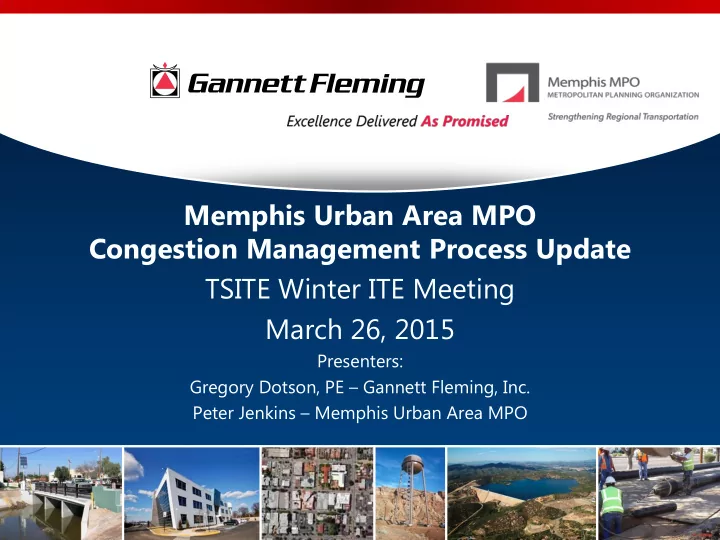

Memphis Urban Area MPO Congestion Management Process Update TSITE Winter ITE Meeting March 26, 2015 Presenters: Gregory Dotson, PE – Gannett Fleming, Inc. Peter Jenkins – Memphis Urban Area MPO
Agenda 1. Introduction and Background 2. How does the CMP fit in with other MPO Plans? 3. CMP Timeline and Development 4. Lessons Learned 5. CMP Performance Measures 6. Engineers thinking like Planners and vice versa 7. Congestion Strategy Toolbox 8. Next Steps
About Memphis Urban Area MPO • Shelby County, TN ▫ Entire county • DeSoto County, MS ▫ Entire county • Fayette County, TN ▫ Western portion • Marshall County, MS ▫ Northwestern portion • * The MPO planning area covers the area that is currently urbanized and what is likely to become urbanized in the next 20 years. • Coordination with West Memphis MPO, AR
Introduction • Congestion Management Process (CMP) – Federally required for large MPOs SAFETEA-LU required that Traffic Management Areas (TMAs) with populations over 200,000 have a CMP MAP-21 retains the CMP requirement featuring a new emphasis on Performance Measurement EPA has designated Shelby County and portions of DeSoto County as non-attainment for Ozone – CMP must demonstrate that new transportation projects don’t result in an increase in air pollution emissions
FHWA Pie Chart: Sources of Congestion Congestion Working Definition: Is the level at which transportation system performance is no longer acceptable due to traffic interference. Source: http://international.fhwa.dot.gov/pubs/pl07012/images/figure_1.cfm
Background • What is a CMP? – A CMP is a process that monitors transportation facilities for congestion problems and seeks to implement congestion mitigation strategies • Memphis MPO’s CMP – Is committed to developing a CMP that emphasizes the need to link the effective management and operations of transportation systems to the planning process, environmental review process and travel demand management • Implementation – Strategies identified in the CMP are used in the development of the Regional Transportation Plan
How Does Everything Fit Together? Travel Surveys Congestion Greenprint, Regional Regional Travel Management other regional Land Use Demand Process Model studies Model 2040 Regional Public/Stakeholder Transportation Outreach Plan Performance Measures Reporting
CMP Project Schedule Current Status Peer Review of CMP Plans Technical Input and Public Input Identify CMP network and strategies Plan Review November March/ April/May June 2015 August Mobility ETC and April 2015 2015 ETC+TPB ETC and Summit TPB DOT and ETC+TPB Adoption TPB October meetings 2014 meetings FHWA and Public of CMP review review
Development of the CMP 1. Peer Review of Best Practices 2. Performance Measures Workshop 3. Mobility Summit 4. Community Remarks 5. Updated Strategy Toolbox 6. Stakeholder Meetings 7. Corridor Audits 8. Identify and Validate the CMP Network
Purpose of CMP Performance Measures • Benefits of Performance Measures – Monitoring provides the MPO with up-to-date performance information and , for the areas and facilities where congestion or deficiencies in mobility or safety are found, it leads to recommendations for improvements to be implemented through the Regional Transportation Plan, LIVABILITY 2040
Memphis MPO Performance Measures 1. Volume to Capacity Ratio 2. Travel-Time Index, Planning- Index, and Buffer Index 3. Number of Crashes 4. Transit Passenger Trips, Bus on-time Performance 5. Miles of Bike Facilities 6. Truck Hours Delay 7. VMT per capita
Engineers thinking like Planners and vice versa • The CMP strives to combine transportation operations with planning • The CMP Strategy Toolbox, which proposes a number of strategies to reduce congestion and increase mobility, reflects both a planning and engineering perspective. • Planning, Transportation and Demographic trends that will influence Congestion and Mobility in the years to come 1. Peak Vehicle Miles Traveled (VMT) reached in the U.S. 2. Close to half of all trips consist of 3 miles or less 3. 2/3 of millennials born after 1984 live in cities 4. People are driving less than before the recession 5. Transit ridership has increased around the U.S.
Using the Strategy Toolbox- Planning • Demand Management Strategies – Land Use Planning policies – Smart Growth – Parking Management – Congestion Pricing – Rideshare • Multimodal Strategies – Complete Streets – Dedicated Transit Travel Lanes – Bicycle and Pedestrian Planning – Park and Ride – Real-time transit information
Using the Strategy Toolbox- Engineering • Operational Improvements – Traffic Signal Improvements – Traffic Calming – Reversible Lanes – Access Management – Road Diets – Ramp Management Strategies • Strategic Capacity Enhancements – New Roadways and Travel Lanes – Bottleneck Removal – Interchange Construction – Freight Capacity Enhancements
Lessons Learned • Know when and when not to think like an Engineer • Don’t just hear what stakeholders are saying, understand them! – The will not care what you have to say until they know how much you care! • When engaging stakeholders, i t’s OK to think like an Engineer; just be sure to speak plainly. • When engaging stakeholders, be careful not to commit to something that may or may not happen. • Beware of people/groups with “hidden” agendas and ulterior motives.
Next Steps • Finish the Memphis MPO Congestion Management Process Document • Review by State and Federal Agencies • Public Review • Adopt the CMP at the Transportation Policy Board of the Memphis MPO
Questions
Recommend
More recommend